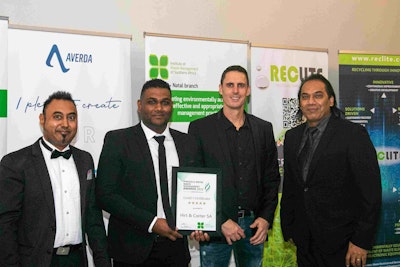All businesses generate some form of waste stream, but many don’t realize that their waste may be considered hazardous and is potentially harmful or even fatal, if not disposed of correctly. So how would a business know if their waste was hazardous and what steps should be followed to ensure compliance with regulations?
Averda asserts that the first thing would be to understand what is defined as hazardous waste. According to the South African Waste Information Centre, hazardous waste is waste that contains organic or inorganic elements or compounds that may, owing to the inherent physical, chemical or toxicological characteristics of that waste, have a detrimental impact on health and the environment.
Hazardous waste may be generated from household, agricultural sector, mining, manufacturing processes, medical facilities, educational institutions, research institutions, and many other sectors.
When hazardous waste is released into the environment, it can spread and contaminate all environmental media, i.e. air, water, and land. It poses a threat to human health and the environment.
The impacts of hazardous waste are determined by four major characteristics, which are:
- ignitability, or something flammable
- corrosivity, or something that can damage eyes and skin
- reactivity, or something that can react violently eg. with water
- toxicity, or something poisonous
Brindha Roberts, Head of Sustainability at Averda, a global integrated waste management company, believes that it is crucial for waste to be correctly classified. This needs to be done as per the Waste Classification and Management Regulations.
Roberts says that classification in accordance with SANS 10234 must be conducted within 180 days of generation and ultimately establishes whether a waste is hazardous based on the nature and the severity of hazard posed.
“Any breach of this protocol could have far-reaching implications. If not properly managed, some forms of hazardous waste can quickly spread and contaminate land, water and air,” Robert explains.
The South African Department of Environment, Forestry and Fisheries (DEFF) manages hazardous waste in South Africa through the National Environmental Management Waste Act which was gazetted in March 2009. The Act sets guidelines for both the management of such waste and for the collection of accurate data around how much of the various types of it are being generated.
The Act provides protection for public health and the environment by providing measures for:
- Minimising the consumption of natural resources
- Avoiding and minimising the generation of waste
- Reducing, reusing, recycling and recovering waste
- Treating and safely disposing of waste as a last resort
- Preventing pollution and ecological degradation
- Remediating land where contamination exits
- Securing ecologically sustainable development while promoting justifiable economic and social development
Other associated regulations include; the Waste Classification and Management Regulations, National Norms and Standards for Disposal of Waste to Landfill, National Norms and Standards for Storage of Waste and so much more.
Importance of recording waste generated in SA
SAWIS has for over a decade recorded routine data on the tonnages of waste generated, recycled and disposed of in South Africa.
“This information allows authorities to keep track of the volumes of hazardous waste that are in circulation and plan accordingly, both at a governmental level and the level of individual businesses and assists to establish duty of care,” added Roberts.
The objective of the national waste information system is to store, verify, analyse, evaluate and provide data and information for the protection of the environment and management of waste within South Africa.
The analysis provided by SAWIS gives vital information on the proportion of hazardous wastage that is recovered via recycling and that which is treated and disposed of. This information is made readily available to the public as well as to government departments and can be requested online in the form of auto-generated reports from the database.
Businesses still unaware of legislation
By law, any company that generates 20kg or more of hazardous waste per day needs to apply for a SAWIS registration number. Gauteng and Western Cape have localised systems - Gauteng Waste Information System (GWIS) and the Integrated Pollutant and Waste Information System (IPWIS)that feed into the SAWIS. Businesses based in either of these provinces would need to apply using their local system.
“Nevertheless, we’ve noticed many smaller firms are still unaware of this legislation, and how it affects their duties and obligations when it comes to hazardous waste,” notes Roberts.
“In fact, around half of the hazardous waste that arrives at Averda’s flagship Vlakfontein landfill site have no SAWIS registration number, which compromises Averda’s own licence requirements, and causes administrative hiccups.
“The waste then needs to be retroactively reloaded onto the system so as not to compromise the accuracy of our reporting or our compliance,” Roberts explains.
Hazardous waste is assessed, and verified, before being accepted for treatment or disposal.
Roberts clarifies that waste is handled according to local regulations, and the specific needs of the client. The various types of hazardous waste require differing approaches.
According to Roberts, the SAWIS application process is simple and can be done online or in hard copy.
“Complying with the DEA SAWIS guidelines is important, not only for the sake of waste management procedures but ultimately because responsible waste management will protect people and the environment”, Roberts concludes.


